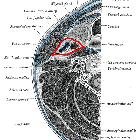deep compartments of the head and neck


The deep spaces of the head and neck refer to compartments delimited by the deep cervical fascia. While these concepts overlap with traditional anatomical description, their existence highlights the importance of fascia in confining various pathologies.
A knowledge of these spaces not only allows for better communication between radiologists and specialists familiar with imaging of this region but also aid in diagnosis as each space has a distinct group of pathologies.
Gross anatomy
Three layers of deep cervical fascia form the boundaries of the deep spaces in the neck :
All three layers contribute to the carotid sheath.
Contents
The compartmental definitions vary somewhat by source . The neck spaces are often divided into the suprahyoid (between the base of the skull and hyoid bone) and infrahyoid (between the hyoid bone and clavicles) spaces, as the anatomy of the deep cervical fascia is slightly different above and below the hyoid bone. Some spaces cross the hyoid bone and course the entire neck.
- suprahyoid neck
- parotid space
- masticator space, including or contiguous with buccal space
- submandibular space, including or contiguous with sublingual space and submental space
- parapharyngeal space (or prestyloid parapharyngeal space )
- suprahyoid and infrahyoid neck
- carotid space (or poststyloid parapharyngeal space in the suprahyoid neck, carotid sheath in the infrahyoid neck )
- visceral space (infrahyoid in some definitions ), including or contiguous with pharyngeal mucosal space (suprahyoid)
- retropharyngeal space, including or contiguous with danger space
- perivertebral space, including prevertebral space
- posterior cervical space
- sternocleidomastoid‐trapezius compartment
- infrahyoid neck
- anterior cervical space
- suprasternal space
- strap muscle compartment
Relations
- parapharyngeal space lies in a central location on each side of the deep face and suprahyoid neck
- visceral/pharyngeal mucosal space is medial to the parapharyngeal space
- submandibular space is anterior to the parapharyngeal space
- masticator space is anterolateral to the parapharyngeal space
- parotid space is lateral to the parapharyngeal space
- carotid (poststyloid parapharyngeal) space is posterior to the parapharyngeal space
- retropharyngeal space is posteromedial to parapharyngeal space
- perivertebral space is posterior to the retropharyngeal space
Related pathology
Many of the disease states that affect the deep structures of the head and neck are confined to one compartment. However, there are some diseases that are trans-spatial. A list of differentials for related pathology can be found in the article for each individual space.
Siehe auch:
- carotid space
- parotid space
- masticator space
- Retropharyngealraum
- superficial mucosal space
- prevertebral space
- anatomy of the head and neck
- Parapharyngealraum
und weiter:

 Assoziationen und Differentialdiagnosen zu deep compartments of the head and neck:
Assoziationen und Differentialdiagnosen zu deep compartments of the head and neck:

